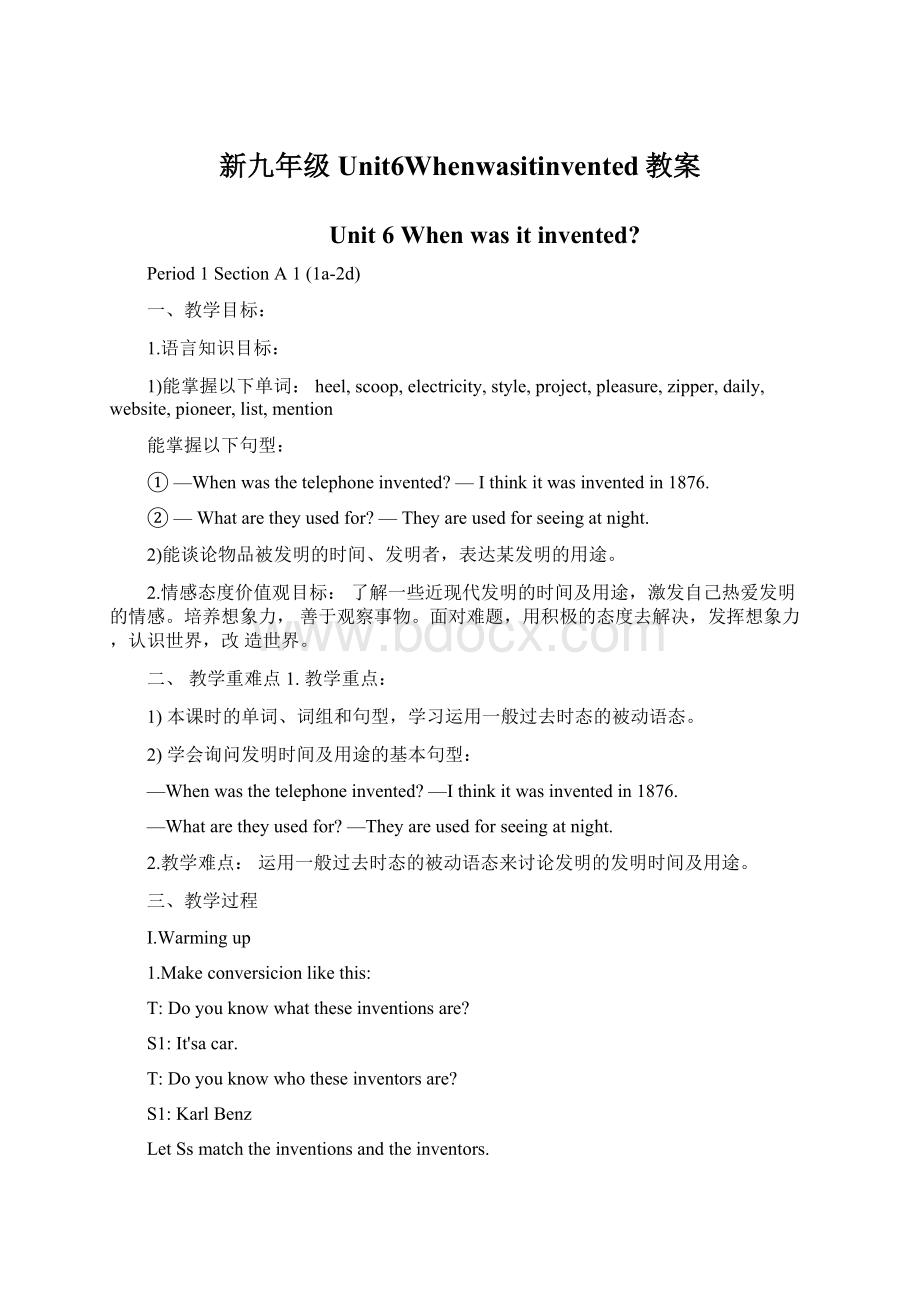新九年级Unit6Whenwasitinvented教案.docx
《新九年级Unit6Whenwasitinvented教案.docx》由会员分享,可在线阅读,更多相关《新九年级Unit6Whenwasitinvented教案.docx(10页珍藏版)》请在冰豆网上搜索。

新九年级Unit6Whenwasitinvented教案
Unit6Whenwasitinvented?
Period1SectionA1(1a-2d)
一、教学目标:
1.语言知识目标:
1)能掌握以下单词:
heel,scoop,electricity,style,project,pleasure,zipper,daily,website,pioneer,list,mention
能掌握以下句型:
①—Whenwasthetelephoneinvented?
—Ithinkitwasinventedin1876.
②—Whataretheyusedfor?
—Theyareusedforseeingatnight.
2)能谈论物品被发明的时间、发明者,表达某发明的用途。
2.情感态度价值观目标:
了解一些近现代发明的时间及用途,激发自己热爱发明的情感。
培养想象力,善于观察事物。
面对难题,用积极的态度去解决,发挥想象力,认识世界,改造世界。
二、教学重难点1.教学重点:
1)本课时的单词、词组和句型,学习运用一般过去时态的被动语态。
2)学会询问发明时间及用途的基本句型:
—Whenwasthetelephoneinvented?
—Ithinkitwasinventedin1876.
—Whataretheyusedfor?
—Theyareusedforseeingatnight.
2.教学难点:
运用一般过去时态的被动语态来讨论发明的发明时间及用途。
三、教学过程
I.Warmingup
1.Makeconversicionlikethis:
T:
Doyouknowwhattheseinventionsare?
S1:
It'sacar.
T:
Doyouknowwhotheseinventorsare?
S1:
KarlBenz
LetSsmatchtheinventionsandtheinventors.
n.Presentation
引导学生们学习一般过去时态的被动语态结构。
T:
KarlBenzinventedthefirstcarin1885.
Thefirstcarwasinvented(byKarlBenz)in1885.
川.Talking
Lookatthepicturesin1a.Discusswithyourgroup,inwhatorderdoyouthinktheywereinvented?
Trytonumberthem[1-4].
IV.Listening(1b)
1.T:
TellSslookatthepicturesandyearsontheleft.
2.PlaytherecordingfortheSstolisten.Sslistentotheconversationandtrytomatchtheinventionwiththeproperyear..Playtherecordingagain..Checktheanswers.
V.Pairwork(1c)
1.Sstrytoremembertheinventionandtheyear.
2.Letsomepairsaskandanswerinpairs.
e.g.A:
Whenwasthetelephoneinvented?
B:
Ithinkitwasinventedin1876.
W.Learningthenewwords&Listening
Lookatthepicturesthenlearnthenewwords.
Workon2a:
T:
TellSstheywillhearsomeinterestinginventions.
1.Lookatthepicturesin2a.Discussthethingswhattheyareusedfor.
2.PlaytherecordingfortheSstolistenandnumberthepictures.
3.Playtherecordingagaintochecktheanswers.
Workon2b:
1.LetSsreadthechartbelow.ExplainsomemainsentencesfortheSs.Makesuretheyknowwhattodo..PlaytherecordingfortheSstofillintheblanks.Playtherecordingagaintochecktheanswers.Listenagainandfillintheblanks.
VD.Pairwork(2c)
TellSstomakeconversationsusingtheinformationin2b.MakeamodelfortheSs.
A:
Whataretheshoeswithspecialheelsusedfor?
B:
Theyareusedforchangingthestyleoftheshoes.
Vffl.Role-play(2d)
1.ReadtheconversationsandLetSsreadaftertheteacher.
2.Explainsomenewwordsandmainpointsintheconversation.
3.AskSstorole-playtheconversationingroups.
Homework
Recitetheconversationin2d.
Period2SectionA2(3a-3c)
一、教学目标:
1.语言知识目标:
1)学习掌握下歹U词汇:
byaccident,ruler,boil,remain,smell,saint,national,
takeplace,doubt,withoutdoubt
2)阅读短文,能按要求找到相应的信息。
3)通过阅读提高学生们的阅读能力。
4)了解茶叶被发明的历史及生产制作的简要过程。
2.情感态度价值观目标:
培养想象力,观察力。
面对难题,用积极的态度去解决,改造世界。
二、教学重难点
1.教学重点:
1)掌握本部分出现的生词和词组,达到熟练运用的目标。
2)阅读短文,获得相关的信息。
通过阅读练习,来提高阅读能力。
2.教学难点:
1)阅读短文,获得相关的信息的能力。
)理解并运用所学的词汇及表达方式。
三、教学过程
I.Revision
1.Checkthehomework.2.Role-playtheconversationin2d.
n.Lead-inLookatthepicturesandaskquestions
1.Whatisthevideoabout?
2.WhoisthewriterofChaJing?
Sstrytoanswerthequestions:
It'saboutthetea.
川.ReadingWorkon3a:
1.TellSstoreadthearticlequicklyandmatcheachparagraphwithitsmainidea.
LuYuandhisbookChaJing
HowteaspreadtoothercountriesHowteawasinventedbyaccident
Para.1
Para.2
Para.3
Ssreadthearticlequicklyandmatcheachparagraphwithitsmainidea.
2.方法指导:
先阅读所给的三句话,然后快速阅读短文,抓住每一段的主题句,
找到答案。
3.学生们,按老师指导的方法进行阅读,并快速阅读三个段落。
4.最后,教师让部分学生回答答案,并校对答案。
Para.1Howteawasinventedbyaccident
Para.2LuYuandhisbookChaJing
Para.3Howteaspreadtoothercountries
Workon3b:
1.告诉学生们再次阅读短文内容,并回答3b中的所有问题。
2.学生们先阅读这些问题,理解它们的意思,然后带着相关问题仔细回读短文,并在短文的相关信息处划线。
3.让学生们回答问题,并校对答案。
4.让学生读一下自己的答案,并改正答案。
IV.Postreading
Readandfilltheblanks.
2.Filltheblanksaccordingtothesecondparagraph.
3.Fillintheblankswiththeproperforms.
4.Workon3c.Completethesentenceswiththeverbsinthebox.
5.Checktheanswers。
Period3SectionA3(GrammarFocus-4c)
一、教学目标:
1.语言知识目标:
1)学习掌握下列词汇:
fridge,low,somebody,translate,lock,earthquake,sudden,all
ofasudden,biscuit,cookie,instrument
2)进行一步复习巩固学习SectionA部分所学的生词和词组。
3)进一步学习运用一般过去时态的被动语态。
4)掌握主动语态变被动语态的方法,并通过不同方式的练习,来熟练运用。
2.情感态度价值观目标:
培养想象力,观察力,用积极的态度去解决,认识,改造世界。
二、教学重难点
1.教学重点:
1)学习生词fridge,low,somebody,translate,lock,earthquake,sudden,allofasudden,biscuit,cookie,instrument
2)复习巩固SectionA部分所学的生词和词组,达到熟练运用的目标。
2.教学难点:
1)一般过去时态的句子变为被动语态。
2)综合运用所学的知识进行练习。
三、教学过程
I.Warming-upandrevision
1.Haveadictationofthenewwordslearnedinthelastclass.
2.Reviewsomemainphraseswelearnedinthelastclass.Checkthehomework.n.GrammarFocus.
1.学生阅读GrammarFocus中的句子,然后做填空练习。
2.学生们根据记忆,看大屏幕来完成填空练习。
3.学生们完成填空试题后,打开课本检查答案,对错误的句子单独进行强化记忆。
川.Grammar
一般过去时态的被动语态的构成.英语有两种语态:
主动语态和被动语态。
主动语态表示主语是动作的执行者,而被动语态则表示主语是动作的承受者。
如:
Wecleanedtheclassroomyesterday.我们昨天打扫了教室。
Theclassroomwascleanedyesterday.教室昨天被打扫。
一、一般过去时被动语态
一般过去时被动语态的结构为主语+was/were+及物动词的过去分词(+by+动作
的执行者).”。
如:
Treeswereplantedlastspring.去年春天种了树。
1.肯定句:
主语+was/were+及物动词的过去分词+其他.
PaperwasinventedbyChinesepeopletwothousandyearsago纟氏是中国人在二千多年前发明的。
2.否定句:
主语+was/werenot+及物动词的过去分词+其他.
Womenwerenotallowedtotakepartinthegames.妇女不允许参加奥运会。
3.一般疑问句:
Was/Were+主语+及物动词的过去分词+其他?
Werethesepicturesdrawnbyyoursister?
这些图片是由你妹妹画的吗?
二、被动语态的用法:
1.不知道谁是动作的执行者,或没有必要指出谁是动作的执行者。
e.g.Englishisspokenallovertheworld.全世界都在说英语。
2.需要突出或强调动作的承受者
e.g.Thisdictionaryisusedbymoststudents.
这本字典是大多数学生在用的。
三、主动语态变被动语态应注意的问题
1.有些短语动词相当于及物动词,变为被动句时介词或副词不能去掉。
Theyputoffthemeetingbecauseoftheweather.
Themeetingwasputoffbecauseoftheweather.会议因天气的缘故被推迟了。
2.含有双宾语的主动句变为被动句时,通常把指“人”的间接宾语变为主语,指“物”的直接宾语保留不变;如果把指物”的直接宾语变为主语,则在间接宾语前加to或for。
Myauntgavemeane-dictionaryyesterday.
Iwasgivenane-dictionaryyesterday.Ane-dictionarywasgiventomeyesterday.
3.主动句中感官动词see/hear/watch/fee等和使役动词make/let/have等后跟省略to
的动词不定式,变为被动语态时应加上不定式符号to。
Isawaheavymanenterthehouse.Aheavymanwasseentoenterthehouse.
4.系动词、不及物动词或某些短语动词(happen,takeplace,cometrue,fallasleep)没有被动语态。
WhathappenedtoMr.Brown?
布朗先生发生了什么事?
IV.Exercises将下列句子变为被动语态。
1.Hechosesixstorybookstheotherday.
Sixstorybooksbyhimtheotherday.
2.UncleLeegaveJackalargecakeforhepaintedthewallwonderfully.
Jackalargecakeforhepaintedthewallwonderfully.
3.Amouseatehalfofthecakelastnight.
Halfofthebyamouselastnight.
将下列句子变为主动语态。
4.WerethesemachinesinventedbyEdison?
Edisonthesemachines?
5.ThepostcardwassenttoLindabyPaul.PaulthepostcardLinda.
6.AmericawasdiscoveredbyColumbus.Columbusdiscovered?
V.Practice
Workon4a:
1.TellSstoreadthesentencesin4aandrewritethesentencesusingthepassivevoice.
2.做题方法点拨示例:
3.最后,教师与同学们一起校对答案,并对学生们有疑问的地方进行解释,或做出合理的分析点拨。
Homework补全下列主动句变被动句。
1.Jennyputherclothesinthesuitcaselastnight.
Herclothesinthesuitcaselastnight.
2.ThetwinssanganEnglishsongthatday.
AnEnglishsong___bythetwinsthatday.
3.Didtheybuildabridgehereayearago?
abridgeherebythemayearago?
4.Theysoldoutthelightgreendressesyesterday.
Thelightgreendressesout.
Period4SectionB1(1a-2e)
一、教学目标:
1.语言知识目标:
1)能掌握以下单词:
crispy,salty,sour,bymistake,customer,theOlympics,Canadian,divide,divide••anketbpopularity,lookupto,hero,professional
2)能掌握以下句型:
1Potatochipswereinventedbymistake.
2ItisbelievedthatthefirstbasketballgameinhistorywasplayedonDecember21,1891.
3Dr.Naismithdividedthemeninhisclassintotwoteamsandtaughtthemtoplayhisnewgame.
4Atthesametime,theyneedtostopthecompetingteamfromgettingtheballintotheirownbasket.
5Thesestarsencourageyoungpeopletoworkhardtoachievetheirdreams.
2.情感态度价值观目标:
了解世界上一些对人类有着重大意义的发明的相关信息,开阔学生的眼界,养成勤于思考,善于发现的好习惯,培养学生的创造精神。
二、教学重难点
1.教学重点:
1)掌握本课时出现的生词及用法。
2)进行听力训练,提高综合听说能力。
3)阅读短文,获得相关信息,提高学生们的综合阅读能力。
2.教学难点
1)听力训练.2)阅读2b部分的短文并完成相关要求。
三、教学过程
I.Warmingup
1.LetSswatchaninterestingpicture.2.Asksomequestionsaboutthem.
(1).Whatdidtheyeat?
S1:
Icecream.
(2).Whatdidthebigdogthinkoftheice-cream?
S2:
Sweet,cool,anddelicious!
Welllet'slookatsomeotherdeliciousfood,please.
n.TalkingWorkon1a
1.TellSsthatthewordsintheboxdescribehowfoodcantaste.Writethemunderthecorrectpictures.Somepictureshavemorethanoneword.
2.Ssworkwiththeirpartnersandtrytowritesomeproperwordsunderthepictures.
3.LetsomeSsreadtheiranswers.Trytorememberthenewwords.
Workon1b
1.LetsomeSsreadtheadjectivewordsintheboxanddiscusswiththeirpartners.Trytowritethenameoffoodaftereachword.Learnthenewwordstogether:
川.ListeningWorkon1c
1.TellSsconversationisabouthowthepotatochipswereinvented.It'svery
interesting.letoneSsreadthesentencesin1c.Makesuretheyknowthemeaningofeachsentence.
2.PlaytherecordingfortheSs.Listenforthefirsttime.PlaytherecordingagainandjudgeTorF.
3.Listenandanswerthequestions.
Workon1d
LetSsreadthearticlein1dfirst.TellSstolistenagainandfillintheblankswiththerightwords.
IV.Pairwork
1.Workinpairs.Makeaconversationabouttheinventionofpotatochips.Usethe
informationin1cand1d.
2.Asksomepairstoactouttheirconversationinfrontoftheclass.
V.ReadingFastReading
TellSstoreadthepassagequickly.Andfindthemainid